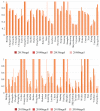A Two-stage Dynamic Undesirable Data Envelopment Analysis Model Focused on Media Reports and the Impact on Energy and Health Efficiency
- PMID: 31052235
- PMCID: PMC6539354
- DOI: 10.3390/ijerph16091535
A Two-stage Dynamic Undesirable Data Envelopment Analysis Model Focused on Media Reports and the Impact on Energy and Health Efficiency
Abstract
Past research on energy and environmental issues in China has generally focused on energy and environmental efficiencies with no models having included the public health associations or the role of the media. Therefore, to fill this research gap, this paper used a modified Undesirable Dynamic Network model to analyze the efficiency of China's energy, environment, health and media communications, from which it was found that the urban production efficiency stage was better than the health treatment stage, and that the energy efficiencies across the Chinese regions varied significantly, with only Beijing, Guangzhou, Lhasa and Nanning being found to have high efficiencies. Large urban gaps and low efficiencies were found for health expenditure, with the best performances being found in Fuzhou, Guangzhou, Haikou, Hefei, Nanning, and Urumqi. The regions with the best media communication efficiencies were Fuzhou, Guangzhou, Haikou, Hefei, Lhasa, Nanning and Urumqi, and the cities with the best respiratory disease efficiencies were Fuzhou, Guangzhou, Haikou, Lhasa, Nanning, Wuhan, Urumqi, Xian, and Yinchuan. Overall, significant efficiency improvements were needed in health expenditure and in particular in respiratory diseases as there were major differences across the country.
Keywords: Two-Stage Dynamic SBM model efficiency; energy efficiency; environmental efficiency; media; public health.
Conflict of interest statement
The authors declare no conflict of interest.
Figures
Similar articles
-
Dynamic linkages among economic development, environmental pollution and human health in Chinese.Cost Eff Resour Alloc. 2020 Sep 7;18:32. doi: 10.1186/s12962-020-00228-6. eCollection 2020. Cost Eff Resour Alloc. 2020. PMID: 32944004 Free PMC article.
-
Impact of Media Reports and Environmental Pollution on Health and Health Expenditure Efficiency.Healthcare (Basel). 2019 Nov 13;7(4):144. doi: 10.3390/healthcare7040144. Healthcare (Basel). 2019. PMID: 31766285 Free PMC article.
-
The impact of media reports on energy and environmental efficiency in China: evidence from modified dynamic DEA with undesirable outputs.Cost Eff Resour Alloc. 2021 Aug 16;19(1):51. doi: 10.1186/s12962-021-00302-7. Cost Eff Resour Alloc. 2021. PMID: 34399783 Free PMC article.
-
The Impact of the Media and Environmental Pollution on the Economy and Health Using a Modified Meta 2-Stage EBM Malmquist Model.Inquiry. 2020 Jan-Dec;57:46958020921070. doi: 10.1177/0046958020921070. Inquiry. 2020. PMID: 32942931 Free PMC article.
-
Effects of FDI on the Efficiency of Government Expenditure on Environmental Protection Under Fiscal Decentralization: A Spatial Econometric Analysis for China.Int J Environ Res Public Health. 2019 Jul 12;16(14):2496. doi: 10.3390/ijerph16142496. Int J Environ Res Public Health. 2019. PMID: 31336960 Free PMC article. Review.
Cited by
-
Energy and Health Efficiencies in China with the Inclusion of Technological Innovation.Int J Environ Res Public Health. 2019 Oct 31;16(21):4225. doi: 10.3390/ijerph16214225. Int J Environ Res Public Health. 2019. PMID: 31683540 Free PMC article.
-
The Energy Efficiency and the Impact of Air Pollution on Health in China.Healthcare (Basel). 2020 Feb 3;8(1):29. doi: 10.3390/healthcare8010029. Healthcare (Basel). 2020. PMID: 32028563 Free PMC article.
-
Efficiency measurement and spatial spillover effect of provincial health systems in China: Based on the two-stage network DEA model.Front Public Health. 2022 Oct 3;10:952975. doi: 10.3389/fpubh.2022.952975. eCollection 2022. Front Public Health. 2022. PMID: 36262222 Free PMC article.
-
Spatial-Temporal Effects of PM2.5 on Health Burden: Evidence from China.Int J Environ Res Public Health. 2019 Nov 25;16(23):4695. doi: 10.3390/ijerph16234695. Int J Environ Res Public Health. 2019. PMID: 31775384 Free PMC article.
-
Comprehensive intuitionistic fuzzy network data envelopment analysis incorporating undesirable outputs and shared resources.MethodsX. 2024 Apr 15;12:102710. doi: 10.1016/j.mex.2024.102710. eCollection 2024 Jun. MethodsX. 2024. PMID: 38660040 Free PMC article.
References
-
- National Bureau of Statistics of China China Statistical Yearbook. [(accessed on 1 December 2017)];2017 Available online: http://www.stats.gov.cn/
-
- International Energy Agency World Energy Statistics (2017), 2018 Edition. [(accessed on 8 April 2018)]; doi: 10.1111/j.1467-9701.1985.tb00423.x. Available online: - DOI
-
- Elliot A.J., Smith S., Dobney A., Thornes J., Smith G.E., Vardoulakis S. Monitoring the effect of air pollution episodes on health care consultations and ambulance call-outs in England during March/April 2014: A retrospective observational analysis. Environ. Pollut. 2016;214:903–911. doi: 10.1016/j.envpol.2016.04.026. - DOI - PubMed
-
- Hu J.L., Wang S.C. Total-factor energy efficiency of regions in China. Energy Policy. 2006;34:3206–3217. doi: 10.1016/j.enpol.2005.06.015. - DOI
-
- Song M.L., Zhang L.L., Liu W., Fisher R. Bootstrap-DEA analysis of BRICS’ energy efficiency based on small sample data. Appl. Energy. 2013;112:1049–1055. doi: 10.1016/j.apenergy.2013.02.064. - DOI
Publication types
MeSH terms
LinkOut - more resources
Full Text Sources
Miscellaneous





